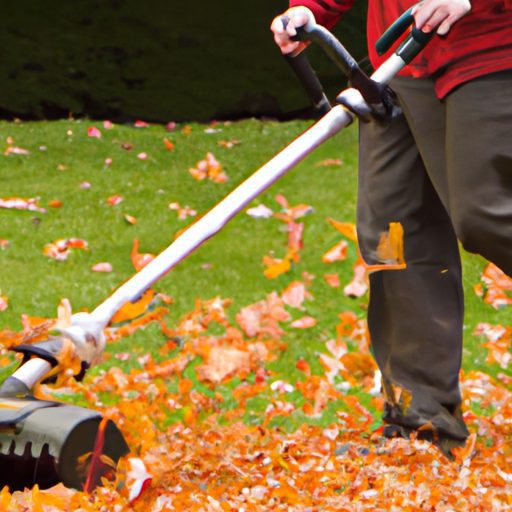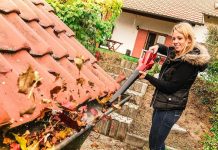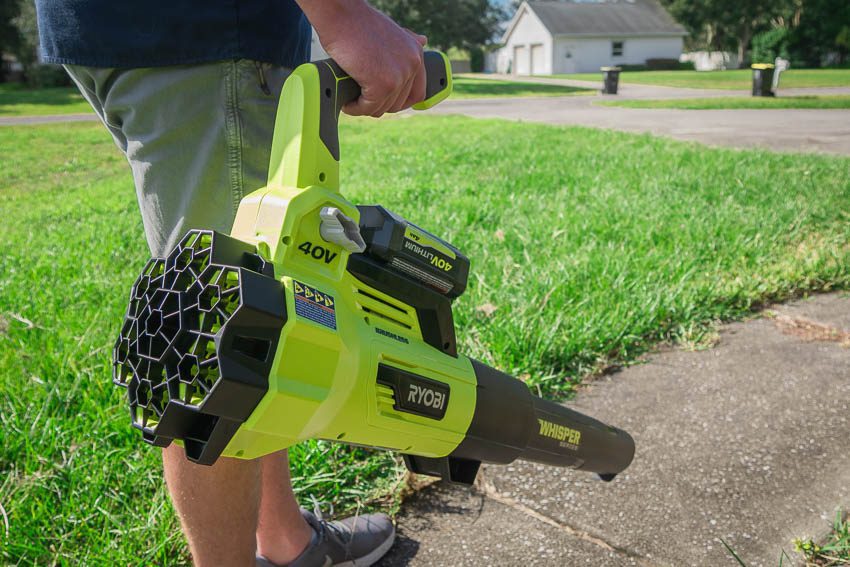Leaf blowers have become indispensable tools for homeowners and landscapers alike when it comes to tackling the never-ending task of leaf removal. But have you ever wondered how these nifty machines efficiently move leaves with such ease? In this article, we will uncover the inner workings of leaf blowers and explore the ingenious mechanisms that allow them to effortlessly create a neat and tidy outdoor space. From the powerful engines to the strategic design, we will reveal the secrets behind the efficient leaf-blowing capabilities of these handy devices.
Leaf Blowers Overview
Leaf blowers are essential tools for effectively and efficiently cleaning up fallen leaves and debris from outdoor spaces. They use the movement of air to dislodge and move leaves, making the tedious task of raking a thing of the past. There are various types of leaf blowers available, each with its own unique features and power sources, catering to different needs and preferences.
Types of Leaf Blowers
Leaf blowers are categorized into three main types: handheld, backpack, and walk-behind blowers. Handheld blowers are the most common and popular type, suitable for smaller areas and lighter tasks. Backpack blowers provide more power and are commonly used by professionals for larger areas, thanks to the harness that distributes the weight of the blower. Walk-behind blowers are designed for heavy-duty tasks, such as clearing large commercial spaces or parking lots.
Power Sources
Leaf blowers can be powered by either internal combustion engines or electric motors. Internal combustion engines are commonly found in gas-powered leaf blowers, offering portability and longer working times. Electric motors, on the other hand, are found in corded electric and battery-powered blowers. Corded electric blowers provide consistent power but require an electrical outlet, while battery-powered blowers offer the advantage of portability but have limited working times depending on the battery capacity.
Common Features
Leaf blowers share several common features regardless of their type or power source. These features include adjustable nozzles, blower tube length and diameter, and variable speed control. Adjustable nozzles allow the user to focus the air in different directions, making it easier to target specific areas or blow leaves into piles. Blower tube length and diameter can affect the airflow distance and volume, allowing for customization based on the cleaning needs. Variable speed control enables users to adjust the blower’s power and airspeed, providing versatility for various tasks.
Principles of Operation
To understand how leaf blowers efficiently move leaves, it is important to explore the principles of their operation. Leaf blowers utilize air movement, centrifugal force, and the combination of airspeed and volume to effectively blow leaves away and create clean outdoor spaces.
Air Movement
The key principle behind leaf blowers is air movement. When the blower is turned on, it generates a stream of fast-moving air that dislodges and propels leaves and debris away. The high-speed air movement makes it easy to clear leaves from different surfaces, such as lawns, driveways, and sidewalks.
Centrifugal Force
Leaf blowers also rely on centrifugal force for their efficient operation. The air movement created by the blower causes leaves and debris to be pushed towards the edges of the blower’s fan or impeller. This centrifugal force helps in separating and redirecting the leaves, making the cleaning process more efficient and effective.
Airspeed and Volume
The combination of airspeed and volume plays a crucial role in efficiently moving leaves. The airspeed determines the velocity at which the air is blown out of the blower, while the volume refers to the amount of air being pushed out. By adjusting the airspeed and volume, users can adapt the blower’s performance to different cleaning tasks, ensuring optimal results.
Air Movement Systems
There are two main types of air movement systems used in leaf blowers: internal combustion engines and electric motors. Each system has its own set of advantages and considerations.
Internal Combustion Engines
Internal combustion engines, commonly found in gas-powered leaf blowers, rely on the combustion of fuel to generate power. They offer superior mobility and extended working times since they are not dependent on an electrical outlet. Two-stroke engines are commonly used in smaller blowers, while four-stroke engines are more prevalent in larger and professional-grade models. However, internal combustion engines produce emissions and require regular maintenance.
Electric Motors
Electric motors are the power source for electric leaf blowers, available in both corded and battery-powered options. Electric blowers are generally lighter and easier to maneuver compared to their gas-powered counterparts. Corded electric blowers provide consistent power but require access to an electrical outlet and may have limitations in mobility due to the power cord. Battery-powered blowers offer portability, but their working time is limited by the battery capacity. They are ideal for smaller outdoor areas and less demanding tasks.
Centrifugal Force
The design of the fan and blades in a leaf blower is crucial for generating centrifugal force, which aids in the efficient movement of leaves.
Fan Design
The fan in a leaf blower typically consists of several blades arranged in a circular pattern. These blades play a significant role in creating the necessary centrifugal force by pushing the air outwards. The shape and angle of the blades can vary, influencing the airflow and efficiency of the blower.
Rotor Blades
The rotor blades in a leaf blower’s impeller help in propelling the air and leaves forward. These blades are strategically placed to maximize the airflow generated by the fan. The design and positioning of the rotor blades impact the blower’s overall performance and its ability to efficiently move leaves.
Impeller Shape
The shape of the impeller also contributes to the leaf blower’s ability to generate centrifugal force. Impellers come in various forms, such as radial or axial, each with its own benefits and considerations. The impeller shape, along with the fan and rotor blade design, collectively determines the blower’s ability to create a strong and efficient airflow.
Airspeed and Volume
The ability to adjust the airspeed and volume is a crucial factor in efficiently moving leaves and debris with a leaf blower.
Adjustable Nozzle Design
Leaf blowers often come equipped with adjustable nozzles that allow users to control the direction and focus of the airflow. By adjusting the nozzle, users can concentrate the air on specific areas or widen the airflow for broader coverage. This flexibility enhances the blower’s efficiency in different cleaning scenarios.
Blower Tube Length and Diameter
The length and diameter of the blower tube also influence the airflow. Longer tubes can help extend the reach of the blower, allowing users to clean areas that are farther away. Similarly, a larger diameter tube can accommodate a higher volume of air, increasing the blower’s overall efficiency. Choosing the right tube length and diameter based on the cleaning requirements ensures optimal performance.
Variable Speed Control
Leaf blowers equipped with variable speed control provide users with the ability to adjust the blower’s power and airspeed. This feature allows for greater control and versatility when dealing with various types of debris and surfaces. Whether blowing leaves on a delicate flower bed or clearing heavier debris, variable speed control enables users to adapt the blower’s performance to the specific task at hand.
Efficiency Factors
Several factors contribute to the overall efficiency of a leaf blower, including air intake and filtration, weight and balance, and noise reduction.
Air Intake and Filtration
Efficient air intake and filtration systems are essential for maintaining the blower’s performance. Clean air filters prevent debris and dust from clogging the engine or motor, ensuring consistent airflow. Regular maintenance of the air intake and filtration components is necessary to prevent any issues that may hinder the blower’s efficiency.
Weight and Balance
The weight and balance of a leaf blower directly impact its ease of use and user comfort. Ergonomically designed blowers with a balanced weight distribution allow users to maneuver the blower effortlessly, reducing fatigue and improving efficiency. Considering the weight and balance when selecting a leaf blower is crucial, especially for longer cleaning sessions.
Noise Reduction
Noise pollution is a significant consideration when operating leaf blowers, especially in residential areas. Many modern leaf blowers are designed with noise reduction features, such as insulated casings and mufflers, to minimize their impact on the environment. Choosing a blower with noise reduction capabilities ensures a more pleasant and considerate leaf-blowing experience.
Common Leaf Blower Techniques
While leaf blowers are primarily used for blowing leaves, there are various techniques that can be employed to efficiently and effectively clean outdoor spaces.
Forward Sweeping
Forward sweeping is the most common technique used with leaf blowers. It involves walking forward while directing the airflow at an angle towards the leaves. This method allows the user to blow the leaves in a controlled manner, forming neat piles or directing them towards a desired location.
Backward Blowing
Backward blowing is another technique used when dealing with stubborn or hard-to-reach leaves. By walking backward and directing the airflow towards the ground, leaves can be dislodged and moved effectively. This technique is particularly useful when working in confined spaces or corners.
Pile Formation
Creating piles is another efficient leaf-blowing technique used to facilitate the collection or disposal of leaves. By blowing leaves into designated areas, users can easily collect them for bagging or composting. Pile formation is especially beneficial when dealing with large quantities of leaves or when working in areas with limited space.
Environmental and Safety Considerations
While leaf blowers are powerful and efficient tools, there are important environmental and safety considerations that should be taken into account.
Noise Pollution
Leaf blowers can generate significant noise pollution, especially when used in residential areas. To minimize disturbance, it is advisable to use leaf blowers during appropriate hours and choose models with noise reduction features. Additionally, being considerate of neighbors and keeping noise levels as low as possible is essential.
Air Pollution
Gas-powered leaf blowers emit exhaust fumes, contributing to air pollution. To minimize the environmental impact, considering electric leaf blowers or choosing models with lower emissions is recommended. Electric leaf blowers produce zero emissions during operation, making them a more eco-friendly option.
Debris Control
When using leaf blowers, it is important to consider debris control to prevent blowing leaves onto neighboring properties or into sensitive areas. By being mindful of the direction and intensity of the airflow, users can avoid creating additional clean-up work for themselves or causing inconvenience to others.
Protective Measures
Leaf blowers generate strong gusts of air, which can potentially cause eye or ear injuries. It is crucial to wear appropriate safety gear, such as safety glasses or goggles to protect the eyes from debris, and ear protection to minimize the risk of hearing damage. Additionally, wearing sturdy clothing and closed-toe shoes is advisable to protect against any potential hazards in the outdoor environment.
In conclusion, leaf blowers are invaluable tools for efficiently and effectively cleaning outdoor spaces. By understanding the types of leaf blowers, the principles of their operation, and the various factors that contribute to their efficiency, users can make informed decisions when selecting and using these tools. Employing proper leaf-blowing techniques and considering the environmental and safety aspects ensures a pleasant and responsible leaf-blowing experience. With the right knowledge and tools, maintaining clean and debris-free outdoor areas becomes a breeze.



































